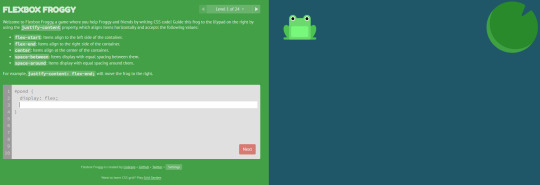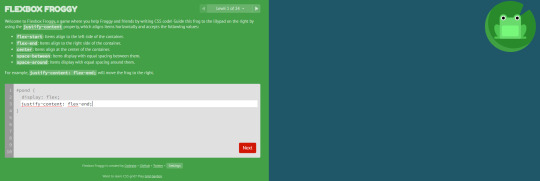#* Frontend development
Text
The FreeCodeCamp Study Challenge!

I literally just completed this challenge and I thought why not share the challenge on here for other people to take part in if they wanted to!
FreeCodeCamp is an open-source platform that offers various coding courses and certifications for web developers. The goal of this challenge is to choose one of the available courses on the FreeCodeCamp platform, complete the course, and earn the certificate at the end.
The challenge is self-paced, so the duration is entirely up to you. The challenge is there to motivate people into coding and/or continue their coding studies! Especially people in the Codeblr community!

FreeCodeCamp [LINK] offers the following courses:
(NEW) Responsive Web Design Certification (I've done this one)
JavaScript Algorithms and Data Structures Certification (I am going to do this one next)
Front End Libraries Certification
Data Visualization Certification
APIs and Microservices Certification
Quality Assurance Certification
Scientific Computing with Python Certification
Data Analysis with Python Certification
Information Security Certification
Machine Learning with Python Certification
Each course is broken down into multiple sections, and completing all the sections in a course will earn you a certification for that course.

To start the FreeCodeCamp Challenge, follow the steps below:
Choose a course on the FreeCodeCamp platform that you would like to complete.
Complete the course and earn the certificate.
Post about your progress every day that you study using the #freecodecampchallenge hashtag. You can post about what you have done towards the challenge, what you have learned, and any challenges you faced and how you overcame them.

The FreeCodeCamp Challenge is an excellent opportunity to improve your coding skills and earn a valuable certification!!!! Even add that to your resume/CV! I completed this challenge and you can see me posting about it - LINK.
Remember to post about your progress using the #freecodecampchallenge hashtag to track your progress and connect with other participants AND you don't have to study straight days, meaning you can take days off whenever you feel like it!
Good luck!
#freecodecampchallenge#freecodecamp#studyblr challenge#study challenge#codeblr#learn to code#progblr#studyblr#cs studyblr#cs academia#computer science#online learning#coding#programming#compsci#studying#webdev#frontend development#html css#html#css#comp sci#100 days of code#coding study#coding bootcamp
256 notes
·
View notes
Text
Learn flexbox!
Although it is IMPOSSIBLE to ever get align-items vs justify-content right on the first try, getting familiar with how flexbox works will allow you to know at least one of them does what you want them to. If there's anything I've learned during my studies it's that development is much more about knowing you can do certain things and being able to google it when you don't know how, rather than having everything memorized. What you need to memorize you will memorize from practice, repetition and experience.
That being said: here are some (two) resources for learning flexbox!


Play Flexbox Froggy
This was such a huuuuuge help for me when learning flexbox. I completed all of the exercises once, and then I would use this as a guide and reference when trying to figure stuff out on my own projects. It's a great interactive way of learning, and it really simplifies and makes flexbox digestible. I recommend just crunching through it once, and you will be exposed to all the different ways of using flex! Then you will have in the back of your head what is possible with flex, and you will be able to recall this and maybe use the next resource to implement it if you don't remember all the keywords yourself!

CSS tricks - a complete guide to flexbox
This was recommended to me by a developer waaay back when i started studying, and it has saved me countless times. It's so good for referencing the different properties, with clear visual examples and a super easy-to-follow structure of the page. I have this bookmarked because of how often I use it.
Good luck in your studies 💻🐸
#css#html#javascript#js#reactjs#react.js#next.js#vite#web development#web developer#frontend#frontend developer#frontend development#software development#coding#codeblr#studyblr#resources#learn how to code#study code#programming#progblr#tech#women in tech#stem#compsci#computer science
192 notes
·
View notes
Text
web developers !!! Help
I need ideas😭😭😭
I havent coded any new websites in like, a month
Send me some asks for ideas??? I'm best at the design portion but I'm learning the interactive part.
#web development#web design#Html#frontend development#Css#javascript#Programming#Programmers#Requests#Kitt.txt
20 notes
·
View notes
Text
youtube
#html#css3#tamilwebdesign#css animation#funny memes#it services#funny stuff#websitedesign#funny but true#webdevelopment#web development#webdesign#website#web design#frontendfriday#frontend development#memes😂#memesdaily#programming#programminglanguage#javascript#javascripttutorial#javascript project#javascriptlearning#javascriptframework#education#youtube#tamilitmemes#tumblr memes
5 notes
·
View notes
Text
Next programming project!
Basically, I can’t decide so youse help me instead. Thank you!! 😋💗

The projects’ overview
POGOBot - A cute chatbot using HTML/CSS/JS/jQuery, maybe React.js(?), JS libraries and some free APIs.
Reason for this project: I want to work more on using APIs, jQuery and CSS media queries.
A bunch of C# console apps - Create a repo with a bunch of C# console applications, maybe 10.
Reason for this project: Basically a refresher on my C#, even working on my C# OOP topics' knowledge.
Create a CSS framework from scratch - self-explanatory really.
Reason for this project: Saw a bunch of kids online create one and was curious about how to make one so I want to make a project of doing so.
Create a chrome browser extension - self-explanatory again. Want to make a pop-up menu type of browser extension.
Reason for this project: Was curious one night and watched a youtube video on how to make one - looks simple but still has the 'challenge' element to it so want to create one.

#codeblr#progblr#studyblr#learn to code#programming#coding#studying#compsci#computer science#cs studyblr#cs academia#webdev#frontend development#code
27 notes
·
View notes
Text
Custom Software Development by Canada Software Company

At Canada Software Company, we work closely with you to transform your ideas into fully functional software solutions. From the initial concept to seamless implementation, our team ensures your software works efficiently at every stage. Our services cover everything from software integration to UI/UX design and thorough quality assurance testing. Let's collaborate to turn your vision into a reality. Reach out today and experience smooth software development tailored to your needs! https://canadasoftwarecompany.ca/custom-software-development/
Website : https://canadasoftwarecompany.ca/
#canada software company#technologies#custom software development#crm software#erp software#education erp#umis#cmis#smis#mis#education erp umis#education erp cmis#education erp smis#education erp mis#platforms#technologies and platforms#frontend development#backend development#devops technologies
0 notes
Text
Unlocking the Power of Component-Based Architecture in Angular
Unlocking the Power of Component-Based Architecture in Angular
Are you tired of dealing with complex and hard-to-maintain Angular applications? Do you want to build scalable and modular frontend applications without compromising on code quality? If so, component-based architecture is here to rescue you!
In this article, we will explore the benefits of component-based architecture and how you can…
0 notes
Text
Best Qualities of a Proficient Front-End Developer

Having a good front-end developer is incredibly important to how a given software or product is used in the real world. They are involved in the creation of the look and feel of a website or application and the overall dynamic of the website.
This task is not only technical but also demands good design sense, user interface, and more importantly feel of the overall development climate. Below is a list of the qualifications that one should possess to be a good front-end developer. If you’re someone looking to make career front-end development, search “Frontend Development Courses Near Me”, and talk to the Team Career Boss Institute.
1. Proficiency in Core Front-End Languages (HTML,CSS,JavaScript):
A good front-end developer must have a deep understanding of the core technologies used to build websites and web applications. They must be able to code the content in the most semantic manner possible. A developer has to be well conversant with CSS, to make the design to favour a wide range of devices and viewports.
2. Familiarity with Front-End Frameworks and Libraries:
Nowadays, basic HTML, CSS, and JavaScript languages remain the essential foundation of the work but the trend in it is based on one or another framework or library to facilitate the processes.
Other work that can be assisted by front-end libraries like jQuery or Bootstrap can also be useful but using them too much should be supported by the developer’s ability to write code in case necessary.
3. Cross-Browser Compatibility:
To achieve this is a core responsibility of the front-end developer to ensure that the created website or application functions well on multiple web browsers. Every browser translates code slightly differently and the good developer has to check and fix mistakes which occurred when working on all the main browsers (Chrome, Firefox, Safari, Edge). Use such techniques as feature detection, polyfills and progressive enhancement to ensure that everything will actually work.
If you’re someone looking to make career front-end development, search “Online Frontend Development Courses Near Me”, and talk to the Team Career Boss Institute.
4. Mobile-Friendly / Mobile-First Approach:
As it is easy for anybody to realise, users interact with web sites from a very broad range of devices, from small screens, low resolutions all the way up to HD resolutions and large displays. Any front-end developer must make sure that their designed front-end looks good at desktop, tablet, or a phone.
This requires: Responsive design involving flexible Grid layouts, the images and CSS media queries depending on the available screen size. The aspect of user experience is very important to make it easy and attractive in all the gadgets used during the usage.
5. Performance Optimization
Measuring the performance of a website and seeing signs such as long loading times negatively affect the site’s success. Developers must be skilled in optimising the performance of their sites by: Compression of images, CSS and JavaScript files and any large and unnecessary assets on the page.
Reducing the page loading time by caching the pages, avoiding the use of very big JavaScript libraries and employing the latest technologies such as utilising the asynchronous loading.
6. Version Control and Collaboration:
Since front-end development is a collective process where people work shoulder to shoulder with designers, back-end developers and project managers.
Version control systems such as Git are a critical component of software development processes that makes possible the software updates and sharing of work with other developers as well as preventing the loss of work. A good front end developer should not have any qualms using Git and tools such as GitHub or GitLab for version control.
7. Attention to detail:
Front end development process is half designing and half coding. For that reason, being a good developer, one should oversee the aspects of a certain design and its visualisation with great attention to details.
This includes: Making sure that the fonts, colours and layouts of the pages are standard with the design template laid down. Enhancing animations as well as transitions to perfection to the flow of user experience. Check to attain that all the parts are properly aligned and to ensure the absence of any glitches that would be conspicuous in visuals.
8. Problem Solving:
The front-end development work comprises solving numerous problems, for instance, determining how a design will be implemented across a range of devices and more so solving complicated JavaScript problems.
One of the most important skills is problem solving as they should be in a position to analyse problems and look for relevant solutions. This needs logical thinking, patience and ability to search solutions through the web and during interaction with developers.
9. Communication Skills:
In the first place, it is crucial to point out that a good front-end developer should be good at communication. It is oratorical to express the ideas, justify the constraints in the technology, and give feedback that is crucial in the functioning of the project. Effective communication helps deliver a product that suits the user and the organisation’s needs as well.
Conclusion
To excel as a front-end developer, one must possess a diverse skill set that combines technical expertise with a keen sense of design and user experience. Mastery in core languages such as HTML, CSS, and JavaScript, along with familiarity with frameworks, libraries, and version control systems, lays the groundwork for effective development. Equally important are skills in optimising performance, ensuring cross-browser compatibility, and maintaining a mobile-first approach to meet the needs of diverse users. To make a career in this sector, search “Online Full Stack Development Course Near Me”, and contact Career Boss Institute.
0 notes
Text
The Future of Frontend Development: Trends and Predictions for the Next Decade
As technology advances, the field of frontend development is rapidly evolving. From new tools and frameworks to innovative design approaches, the future of frontend development is set to bring exciting changes. In this blog, we'll explore the key trends and predictions that are expected to shape the next decade of frontend development.

1. The Rise of WebAssembly (Wasm)
One of the most groundbreaking developments in frontend development is the rise of WebAssembly (Wasm). WebAssembly is a binary instruction format designed to execute code at near-native speed in web browsers. This technology allows developers to use languages like C, C++, and Rust to build web applications, breaking free from the traditional reliance on JavaScript.
What This Means for the Future:
Performance Boost: WebAssembly enables high-performance web applications that were previously difficult to achieve with JavaScript alone. This opens the door for more complex applications, such as 3D graphics, video editing, and games, to run smoothly in the browser.
Broader Language Support: As more languages are compiled into WebAssembly, developers will have greater flexibility in choosing the best tools for their projects, potentially leading to more diverse and innovative web applications.
2. Continued Dominance of JavaScript Frameworks
JavaScript frameworks like React, Vue.js, and Angular have become staples in frontend development, and their influence is only expected to grow in the coming years. These frameworks provide the building blocks for creating interactive and dynamic web applications, making them essential tools for modern developers.
What This Means for the Future:
Ecosystem Expansion: The ecosystems around these frameworks will continue to grow, with more libraries, tools, and plugins being developed to enhance their functionality.
Improved Developer Experience: Frameworks will focus on improving developer experience, with better tooling, more efficient state management, and enhanced debugging capabilities.
Increased Adoption of Component-Based Architecture: Component-based development, popularized by these frameworks, will become the standard approach, promoting reusability and maintainability of code.
3. Progressive Web Apps (PWAs) Becoming the Norm
Progressive Web Apps (PWAs) are web applications that offer a native app-like experience. They can work offline, send push notifications, and be installed on a user’s device, blurring the line between web and native apps. As users demand faster and more reliable experiences, PWAs are expected to become more prevalent.
What This Means for the Future:
Wider Adoption by Businesses: More businesses will invest in PWAs as a cost-effective alternative to native apps, especially for reaching a broader audience without the need for platform-specific development.
Enhanced Capabilities: Advances in browser APIs will allow PWAs to access more native features, further closing the gap between web apps and native apps.
SEO Benefits: PWAs, being indexable by search engines, will continue to offer advantages in SEO over traditional native apps, making them an attractive option for content-driven businesses.
4. The Growth of Jamstack Architecture
Jamstack (JavaScript, APIs, and Markup) is an architecture designed to make the web faster, more secure, and easier to scale. By decoupling the frontend from the backend and leveraging static site generation, Jamstack offers a modern approach to building websites and apps.
What This Means for the Future:
Faster Websites: Jamstack sites are pre-rendered and served as static files, resulting in lightning-fast load times and improved performance.
Scalability and Security: Since Jamstack sites rely heavily on CDNs and APIs, they are easier to scale and inherently more secure, reducing the risk of server-side vulnerabilities.
Increased Adoption by Enterprises: As enterprises seek to improve site performance and user experience, Jamstack will see increased adoption, especially for content-heavy sites and e-commerce platforms.
5. AI and Machine Learning Integration
The integration of AI and machine learning into frontend development is set to revolutionize the way web applications are built and how users interact with them. From personalized user experiences to intelligent automation, AI will play a significant role in the future of frontend development.
What This Means for the Future:
Personalized User Experiences: AI will enable more personalized user experiences by analyzing user behavior and adapting content and interface elements in real-time.
Enhanced Design Automation: AI-driven tools will assist in design tasks, such as generating layouts, optimizing UI components, and even writing code, reducing the time and effort required for development.
Improved Accessibility: AI can help make web applications more accessible by automatically generating alt text, captions, and other assistive features, ensuring a more inclusive web experience.
6. The Evolution of CSS and Design Systems
CSS has been a fundamental part of frontend development, and it continues to evolve. With the introduction of new features like CSS Grid, Flexbox, and custom properties (CSS variables), developers have more power than ever to create sophisticated layouts and designs.
What This Means for the Future:
Advanced Layout Capabilities: The continued evolution of CSS will enable more complex and responsive layouts, making it easier to create visually stunning web applications.
Design Systems and Component Libraries: The use of design systems and component libraries will become more prevalent, promoting consistency across large-scale projects and improving collaboration between designers and developers.
CSS-in-JS: The trend of writing CSS within JavaScript (CSS-in-JS) will continue to gain traction, particularly in React and other component-based frameworks, offering better performance and more dynamic styling options.
7. The Shift Toward No-Code and Low-Code Development
The rise of no-code and low-code platforms is democratizing web development by allowing non-developers to build websites and applications with minimal coding knowledge. These platforms offer drag-and-drop interfaces and pre-built components, making web development more accessible.
What This Means for the Future:
Empowering Non-Developers: As no-code and low-code platforms mature, more businesses will be able to create and manage their own web applications, reducing reliance on development teams for simpler projects.
Accelerated Development Cycles: Even professional developers will leverage these platforms to speed up development cycles, allowing them to focus on more complex and custom features.
New Challenges for Frontend Developers: While these platforms simplify certain aspects of development, frontend developers will need to adapt by focusing on more specialized and advanced areas where custom coding is still required.
8. The Importance of Web Performance and Core Web Vitals
Web performance has always been a critical factor in frontend development, but with the introduction of Core Web Vitals by Google, it has become even more crucial. Core Web Vitals are a set of metrics that assess the user experience on a website, including loading performance, interactivity, and visual stability.
What This Means for the Future:
Performance-Driven Development: Frontend developers will increasingly prioritize performance optimization, as it directly impacts SEO rankings and user retention.
Tools and Frameworks Adaptation: Tools and frameworks will continue to evolve to help developers optimize for Core Web Vitals, offering built-in features for measuring and improving performance.
Greater Focus on User-Centric Metrics: As web performance becomes a more significant factor in determining a website’s success, developers will need to pay close attention to user-centric metrics and ensure their sites meet the highest standards.
Conclusion
The future of frontend development is set to be dynamic and full of innovation. From the rise of WebAssembly and Progressive Web Apps to the growing importance of AI and machine learning, the next decade will bring significant changes to how websites and applications are built. By staying informed about these trends and embracing new technologies, frontend developers and businesses can ensure their digital products remain competitive, user-friendly, and ahead of the curve.
1 note
·
View note
Text
Frontend development can be a challenging and time-consuming process. Custom frontend development, in particular, requires skilled developers with expertise in the latest technologies and frameworks. Angular is a powerful frontend development framework that can help streamline the custom frontend development process. In this article, we will discuss how skilled Angular developers can assist in custom frontend development, and how to find the best Angular developers for your project.
#frontend#frontend development services#frontend development#frontend developer#frontend application#ahextechnologies
0 notes
Text
Bro big fuck you to samsung for making the galaxy fold so small, now I have to account for that in my websites so it doesn't look like this

0 notes
Text
Completed the #freecodecampchallenge



◀ previous day
Completed the penguin!! And now on the very last project, I am so happy to end this course, oh my goodness! The last project was to build a portfolio page! Obviously, this won't be my official portfolio page as I am still planning that but this can be practice! As you can tell, I just coded this up last night because I was in hyperfocus mode~!
I have gotten down some of the HTML in the morning and then worked on the media queries in the afternoon! The worst part for me. I’ve added 4 projects I liked from the whole challenge overall and one I added that I liked as well! But I am so happy to finish this course completely! Got a neat certificate as well!
I started the challenge on 9th Jan and ended it last night 24th February so that's really 1 month and 15 days (46 days because I took a week break)!
I will continue to do the other certifications such as the JavaScript course, just for myself 🥰

💻 What I did today towards the challenge 🎨
☆ Completed the #freecodecampchallenge ✅

Have a nice day/night and happy coding 🤎 check out my freecodecamp profile 🙌🏾

#freecodecampchallenge#freecodecamp#codeblr#progblr#studyblr#coding#programming#computer science#compsci#studying#webdev#frontend development#html css#html#css#comp sci
45 notes
·
View notes
Text
Last day of school (first day of break)






ft pics from my walks
let today = new Date(16 June 2023);
Today was the last day of school, and now I am officially done with all the "studying" part of my education and I am very conflicted in how I feel about it.
Next semester is going to be individual projects, and then internships, and in approx 9 months from today I will be getting my diploma and hopefully land a job. 9 months is less time from today to when I created this blog, which is like wtf cause in itself it doesn't feel like too long ago!
Creating this blog was one of the best things i did for myself during my studies. Even though maybe I have not been as active with my own content as i was originally planning to, I've really found support in this community and knowing that I am not alone on this journey. If you're thinking of starting your own codeblr: do it!! You don't have to be the most active, or the best at what you do, any content is worth sharing in my opinion. If not for others, then for yourself, to look back and see how far you've made it. All victories are worth celebrating, no matter how small.
Going into this summer break and the next chapter approaching with internships and my individual project, I am honestly feeling a bit apathic. I struggle with chronic depression and anxiety, but alongside being a ruthless perfectionist I am able to pass my courses and do what I need to do to barely meet my own (very ambitious) standards, but it takes a toll on me, and these last few weeks of school were unlike anything I have experienced before as far as mental health x school goes. But I fkn made it!! Nice walks help (the times I can convince myself to go out) (pictured in the images hehe), showing up even when i feel like crap helps, and accepting support from close ones help.
I think it's difficult to open up and share my mental health struggles, both online and offline, but I am hoping this makes someone else feel less alone. Living, let alone studying, with mental health struggles is ass. It fucking sucks and it can feel like walking in deep water while others are swimming past you and telling you to just do the same. (omg wow so deep analogy) If only it were that easy lol. But we are so strong! and wether you are pursuing a degree/career or just trying to manage life, you're gonna kick ass, one step at the time.
Happy coding and happy summer to my fellow northern hemispher-ers 😎
#codeblr#studyblr#mental health#frontend development#frontend developer#studyspo#uni#university#light academia#programming#progblr#software developer#How did i originally make the date 16 july#can you tell im stressed lmao...
58 notes
·
View notes
Text
I'm making a windows app.
Any ideas on what fun things i should add ?
5 notes
·
View notes
Text
#webdesign#html#tamilitmemes#css3#tamilwebdesign#css animation#web design#web development#website#frontend#backend#backendcoding#backendengineer#backenddeveloper#backenddevelopment#frontenddev#frontenddesign#frontend development#frontend design#fullstackdevelopment#fullstackdeveloper#fullstackdev#fullstackwebdeveloper#fullstack#full stack developer#full stack web development
4 notes
·
View notes
Text
WEB APPLICATION DEVELOPEMENT - SPARK TECHNOLOGIES

The key first step in the development cycle is to ascertain each client’s individual needs and objectives. By understanding these from the outset,
we position ourselves to deliver powerful, scalable, and custom-made web applications tailored to their specific requirements.
Click here for more
1 note
·
View note